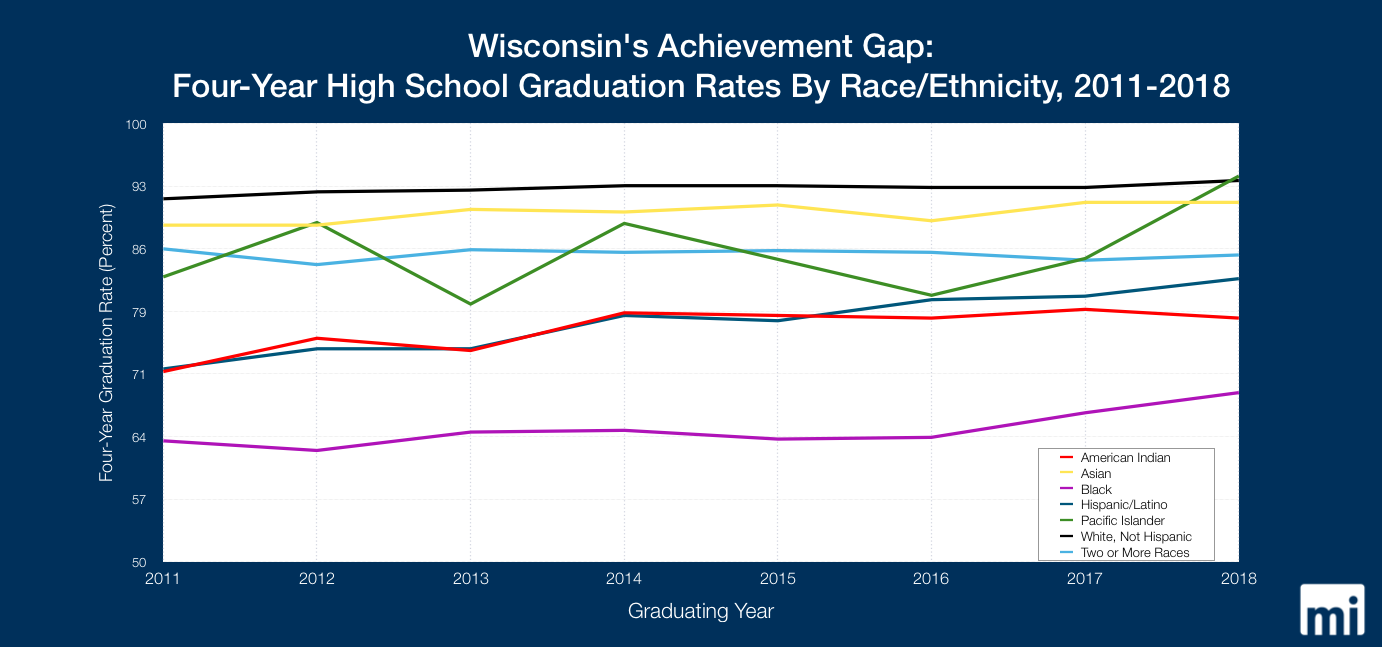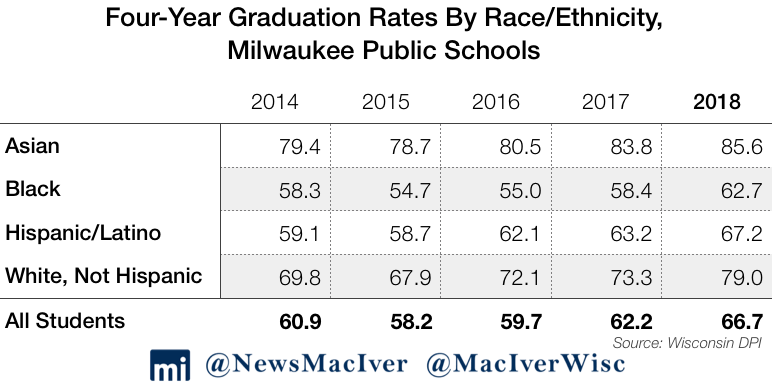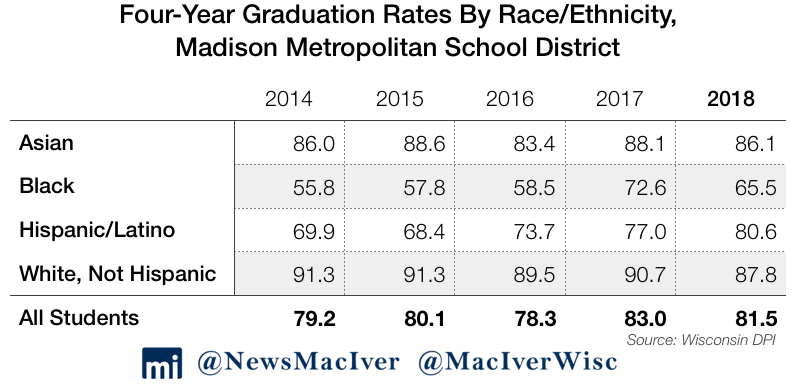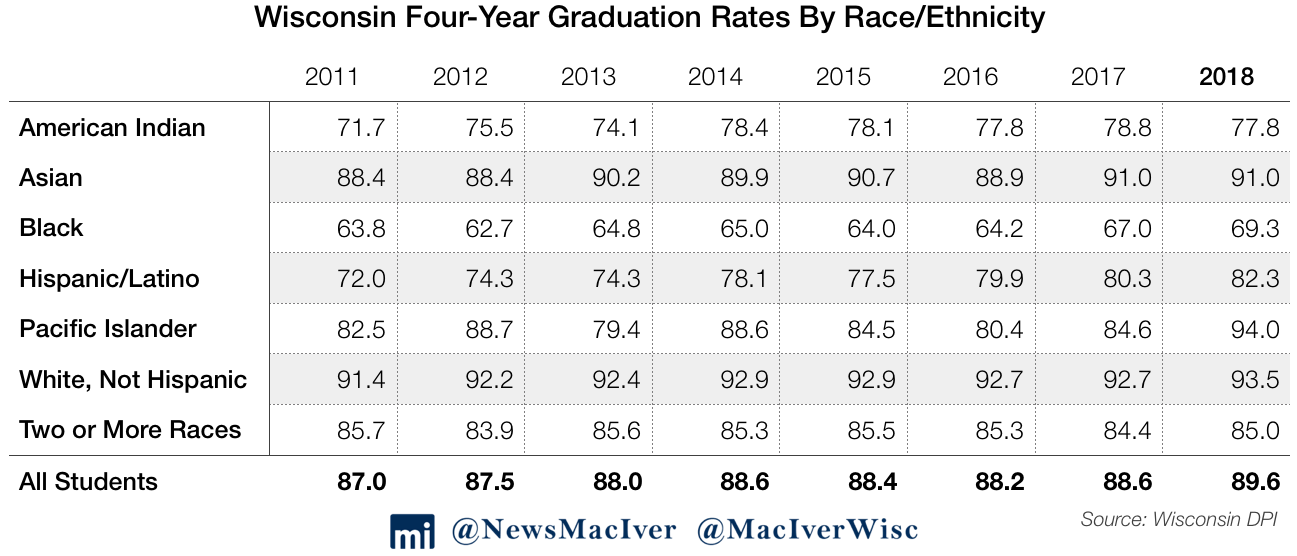
A new dataset shows the graduation rate is increasing, more students are opting out of college, and disciplinary issues are rising. What does the data show within some of Wisconsin’s largest districts?
February 19, 2018
By Ola Lisowski
The state’s Department of Public Instruction (DPI) recently released a new dataset on student performance across Wisconsin. We took a first look at those figures here, highlighting that graduation, discipline, and Advanced Placement (AP) Exam participation rates are up, while enrollment continues to fall.
The achievement gap between white and black Wisconsin high school students has fallen, according to a new data release.
Today, we’ll take a deeper dive into achievement gaps and examine how some of Wisconsin’s largest districts are faring on the new metrics.
Achievement Gaps
Wisconsin’s students have long been plagued by racial disparities in graduation rates, at times posting the largest achievement gap between black and white students in the country.
The new dataset shows that the achievement gap is still prevalent, with the graduation rate for white students 24.2 percentage points higher than for black students.
The figure has stayed relatively stagnant over time, but is beginning to shrink. In 2011, the statewide black-white diploma gap was 27.6 points. This year’s figure is the smallest gap between the two groups in many years.
The figures show that black students are catching up to their peers, with the statewide black graduation rate now at 69.3 percent, up from 67 percent in 2017. White students graduated at higher levels this year, but did not increase their rates as quickly.
Other racial groups also saw impressive growth in graduation rates in 2018. At 94 percent, Pacific Islander students posted the best four-year graduation rate of any racial or ethnic group, beating out non-Hispanic white students (93.5 percent) and Asian students (91 percent).
Almost every group increased average graduation rates, except for American Indian students, whose rate fell by 1 point to 77.8 percent. Asian students maintained the same graduation rate of 91 percent, still above the all-student average of 89.6 percent.
At 66.7 percent, the overall graduation rate at Milwaukee Public Schools (MPS) was lower than the state average, though MPS’ rate grew by an impressive 4.5 percentage points over the past year. In 2017, 62.2 percent of MPS students graduated high school in four years.
Students of every major racial and ethnic group at MPS improved their graduation rates, though some groups improved faster than others. The diploma gap between white and black students at MPS increased from 14.9 percentage points in 2017 to 16.3 points in 2018. 
Black students make up the majority of MPS’ student body. While the achievement gap increased over 2017, the gap is smaller than the state average.
In the state’s capital, a smaller percentage of students at Madison Metropolitan School District (MMSD) graduated in four years, compared to the prior year. The class of 2018 posted an 81.5 percent four-year graduation rate, down from 83 percent. Most major ethnic and racial groups did worse than the previous year at MMSD, except for Hispanic/Latino students who slightly improved their figures.
The diploma gap between white and black Madison students is now 22.3 percentage points, greater than at MPS but slightly smaller than the state average. That achievement gap has worsened from 18.1 points for the class of 2017.
now 22.3 percentage points, greater than at MPS but slightly smaller than the state average. That achievement gap has worsened from 18.1 points for the class of 2017.
Discipline
As we detailed last week, disciplinary measures have increased statewide over the last year. The state’s large districts showed similar trends.
In 2018, MPS reported 24,371 total incidents involving assaults, drugs and alcohol, endangering behavior, weapons, and all other school rule violations. The figure increased by 24 percent over 2017, when 19,686 such cases were reported.
Approximately one-third, or 32.3 percent, of MPS students were involved in a disciplinary case in 2018. In 2018, 124 students were expelled. Both of those figures were higher than in 2017, when 25.8 percent of students were involved in an incident and 104 students were expelled.
At MMSD, 9.2 percent of all students were involved in a disciplinary incident in 2018, up from 7.5 percent in 2017. Suspensions were also up, from 7.5 percent to 9.2 percent. The district had four expulsions in both 2018 and 2017.
Looking at the sheer number of student incidents in the district, MMSD reported 2,469 overall cases in 2018. That was a 22 percent increase from 2017, when the district reported 2,023 such cases.
Green Bay Area Public Schools (GBAPS) showed a similar increase in the number of disciplinary cases within the district, with the number of overall incidents increasing by 8 percent in one year. In 2018, the district posted an overall student incident rate of 14.8 percent, up from 13.4 percent in 2017. The overall number of incidents increased from 2,824 incidents in 2017 to 3,054 in 2018.
However, punishments seemed to increase dramatically compared to the incident rate. In the 2017-18 school year, the district expelled 14 students. The prior year, zero students had been expelled.
Differing Trends: A Rise in AP, but a Fall in College Attendance
Two recent trends have emerged for Wisconsin students, and taken together, they seem rather peculiar. While the number of AP Exams taken has increased by a stunning 61 percent since 2010, fewer students are enrolling in post-secondary education.
That measure shows the percentage of 2018 graduates who are now enrolled in some kind of institute of higher learning, whether it’s a public or private, two- or four-year university or technical college. DPI updates the college attendance statistic twice a year, so the initial figure slowly ticks up after students complete gap years or decide to go back to school after some time.
Still, the trend is clear — 59 percent of 2018 high school graduates statewide are now enrolled in a college of some sort, significantly below the 69 percent of 2013 graduates doing the same. For a multitude of reasons, young people are turning away from universities and trade schools and ending their education, at least for the time being, with high school.
A look into large districts showed a similar trend. Just under two-thirds, or 65.3 percent of MMSD students who graduated in 2018 are attending college, down from 70.3 percent of 2017 graduates.
MPS graduates are less likely to go onto postsecondary education, with 41 percent of 2018 graduates enrolled elsewhere today. The trend at MPS is even more stark than the statewide trend, as 55 percent of 2013 MPS graduates are enrolled at a postsecondary institute.
While more students are taking AP Exams to earn college credit before high school graduation, many others are forgoing post-high school education altogether.
Graduates of Racine Unified School District (RUSD) are making similar choices. Less than half, 49 percent, of 2018 RUSD graduates are enrolled in a college of some sort. Of 2013 graduates, 65 percent have done the same. The same is true in GBAPS, where 53 percent of 2017 graduates are enrolled in a college or trade school. Of 2013 graduates, 71 percent have done the same.
Yet as more students turn away from going to college immediately after high school, others are preparing for college more than ever before. More students are taking more AP Exams and earning college credit before graduating high school. In 2018, 17 percent of Wisconsin high schoolers took an AP Exam.
At MPS, 9.6 percent of AP Exams taken in May 2018 had scores of three or higher, the score generally considered to be a cutoff for college credit. The number of exams taken by MPS students fell slightly, from 3,004 to 2,977, but more students overall participated in AP Exams. In 2018, 9.7 percent of MPS students took an AP Exam, up from 6.5 percent of students in 2013.
One-fifth of MMSD students took an AP Exam in 2018, up from 18.9 percent in the previous year. The number of credit-earning exams among MMSD students has slowly fallen over time, though at 77.4 percent of tests scored three or higher, the rate is better than the state average.
Enrollment, Attendance, and Dropouts
Enrollment statewide continued to tick downward, falling by 0.15 percent from 2017. Large districts reported similar trends. MMSD reported a 0.19 percent change in student enrollment, and MPS reported a 0.14 percent fall. At GBAPS, enrollment fell by 1.32 percent. RUSD reported a 1.47 percent decline in student enrollment, bringing that district below 18,000 students for the first time in years.
In Milwaukee, the attendance rate was 87.7 percent in the 2017-18 school year, continuing a three-year decline. The dropout rate also fell from 5 percent to 4.7 percent. Similar trends played out in MMSD, where the attendance rate was 92.6 percent and the dropout rate was 1.8 percent. RUSD’s attendance rate also fell from 90.5 percent to 89.2 percent in 2018. At the same time, the dropout rate fell from 3.8 percent to 3.1 percent.
Green Bay students showed the only deviance from the trend in this regard, with the dropout rate increasing from 2.5 percent in 2017 to 2.8 percent in 2018. The attendance rate fell, albeit just by a hair, from 92.7 percent to 92.5 percent.

